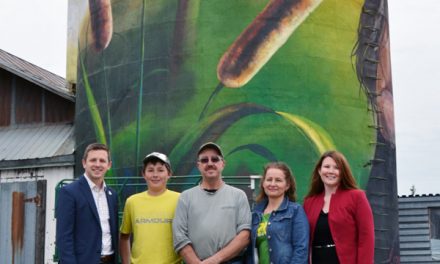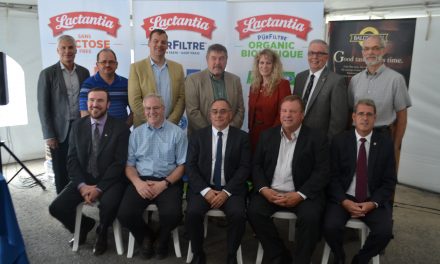Dundas County Holstein Club’s twilight
The Gilmer family of Ricrodreg Farms hosted the Dundas County Holstein Club’s annual twilight extravaganza on Wed., July 18. The Gilmers had a long day after welcoming guests to their open barn celebration from 9 a.m. to 4 p.m. they then hosted the Holstein Club’s twilight meeting. The crowd was treated to a dinner catered but the Leather Works Catering service and between 250-300 plates were served during the evening. Little Ray’s Reptiles were on scene with a few different little critters for kids of all ages. The cowers of Ricrodreg Farms posed by a series of pictures that depicted different eras of the Gilmer family’s heritage. From left, Reg, Trevor, Richard, Jeff and James Gilmer. Moore photo

Standing on top of one of the Lely Astronaut A4 robotic milking system is a view of the Gilmer’s new barn. The Gilmers welcomed guests to their open barn on Wed., July 18, located south of South Mountain on Carman Rd. The Gilmers milk 210 cows with four robotic milkers. Moore photo
by Jeff Moore
AgriNews Staff Writer
SOUTH MOUNTAIN — The Gilmer Family of Ricrodreg Farm welcomed guests to their recently completed fully automated barn on Wed., July 18, just south of South Mountain for an open barn celebration. The Gilmers have had a long history in the area beginning in the mid 1800s. The Gilmer’s ancestors arrived in Canada in 1832 and spent seven years in the eastern Quebec townships before moving to Iroquois. The family bought four oxen and settled in Pleasant Valley.
In 1840, John Gilmer received 100 acres of bush from the British Empire and by 1851 he had cleared 20 acres and 30 by 1861. The family cropped wheat, oats, peas and Indian corn to feed their growing livestock. These included sheep, pigs, steers and milking cows.
The family continued to farm at that location heading into the late 1800s by the next generation of Gilmers. The Gilmers began to focus on milk production and in 1875, Gawn Gilmer erected a cheese factory which he and his son Tom operated until 1939.
The cheese factory is still located just south of Hulbert. In the mid 1940s after the great depression, the Gilmers upped their production due to the need of food supply for the Second World War and they expanded their milk production through the 40’s and 50’s.
The Gilmers began to breed holsteins and committed to solely produce milk as their business. Dwight Gilmer began working with his father at the age of 20; electricity was then introduced to the area and they purchased their first milking machinery.
They also bought their first tractor in the 1950’s; it was an International W4. At that time they were primarily growing feed for their cattle such as corn, hay and barley. From the early 1960’s, the Gilmers were committed entirely to milk production and milked between 25 to 45 head of holsteins. In 1965, the farm switched from milk cans to a bulk tank and pipeline and they also bought their first forage harvester.
The farm grew to approximately 300 acres and Dwight’s son, Richard joined the farm in the late 1960’s and used the extra land for pasture, corn, hay and oats and barley. The Gilmers grew the herd to 70 cows between 1970 and 1980 and built a heifer barn for extra cattle.
Gilmers continued to breed holsteins and began to feed more forages. They installed tile drainage to increase the yields of their crops. Dwight’s son, Reg joined the farm in the mid-80’s and in the 90’s they focused on improving efficiencies and genetics. The Gilmer’s purchased their first TMR feeding system in 1992. In 1998, the Gilmers went from tie-stalls to a sand bedded free-stall system and increased the size of their herd to 150.
At the time, the farm was 100 per cent tile drained and they switched to bunker silos for feed storage. Jeff and James Gilmer started working on the farm in 2009 and were up to 600 acres including a mixture of corn, soybeans, hay and small grains.
Technology allowed the Gilmers to increase the size of their herd in the past 18 years and more land was bought growing the farm to 1,000 acres and another 200 acres were still forested. In 2013 they began milking three times daily and in 2016 the farm would invest in robotic milkers and a new barn. The farm then had enough acreage to do some cash cropping for extra income.
Rideau-St. Lawrence Veterinary Services were the main provider of the Gilmers for over 30 years and took part in the design of the new barn.
Quoting a posted sign at the open barn the veterinary service said, “it was a proud member of the design team creating a spacious, state-of-the-art dairy facility designed to optimize cow comfort, health and performance and ease of animal handling,” and went on to congratulate the Gilmer family.
The new barn featured deep-bedded sand for production, lameness and longevity, 50” wide spacious stalls that are less restrictive that allows more comfortable lying positions, optimal stall lengths for proper lunge, 18 foot platform for head stalls, wide stall dividers 38” top to bottom and it enables cows to side lunge, if necessary, and brisket locators.
The ventilation system and heat abatement system included 15 3’ x 3’ exhaust chimneys to remove stale air from the barn, 14 foot opening in the outer wall for natural ventilation, 52” belt driven fans spaced 36 feet apart that moves air at 400 ft/min., sprinklers along the feeding line for evaporative cooling, and fans along the feed bunk. Facilities included 30” of bunk space, 120 square feet of lying space for cows and waterers located with access from scrape alley to prevent wetting straw pack, a pen for dry cows for up to 21-28 days before due date. Robotic features included are 4 Lely A4 Astronaut milkers two of which were “L” shaped and two tollgate style, robotic entrances and exits to reduce crowding and removable footpaths set-up at exit of robot.
The barn also features wide 14 foot scrape alleys and crossovers for stress-free cow flow, a 12 foot stall alley with crossover width of 14 foot, minimum crossover heights are between 3 1/2 and five inches and grooved floors.
Also featured was a Houle manure handling system. The Gilmer’s guess that approximately 200-250 people had visited the open barn from 9 a.m to 4 p.m. and then prepared to host the Dundas County Holstein Club’s Twilight celebration.













